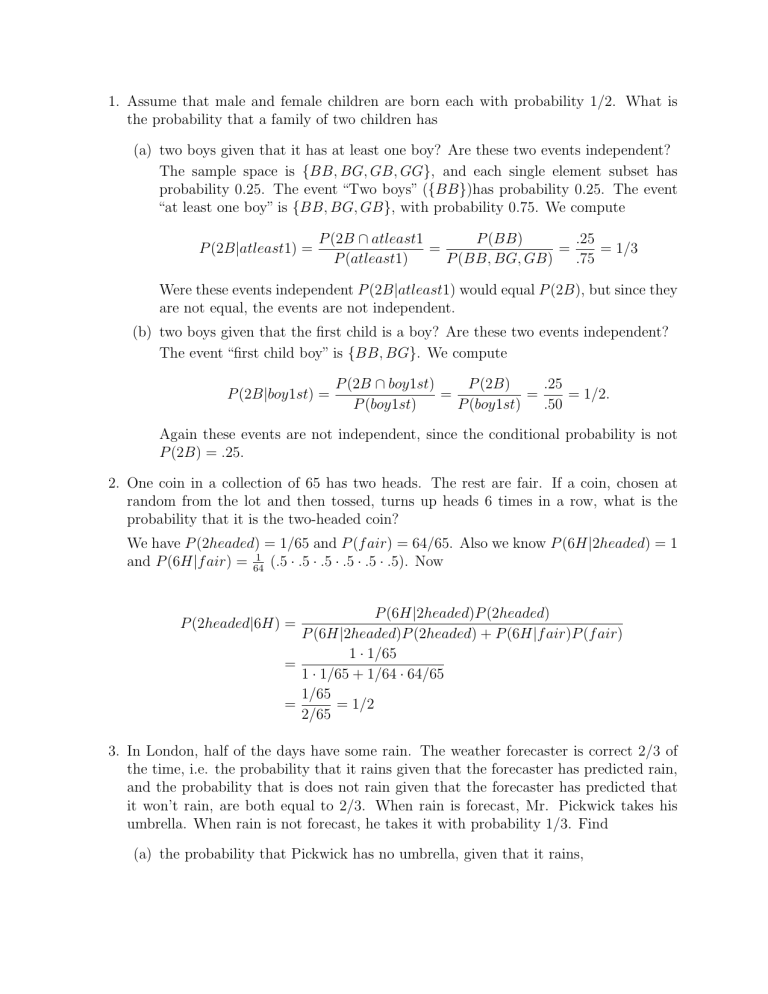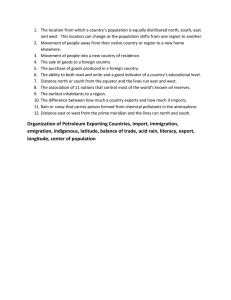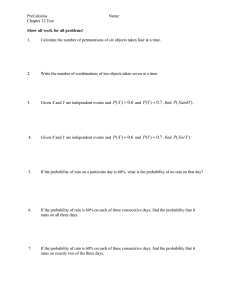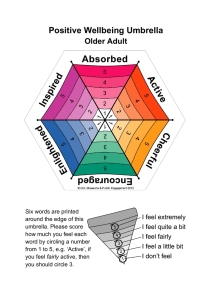1. Assume that male and female children are born each with

1. Assume that male and female children are born each with probability 1/2. What is the probability that a family of two children has
(a) two boys given that it has at least one boy? Are these two events independent?
The sample space is { BB, BG, GB, GG } , and each single element subset has probability 0 .
25. The event “Two boys” ( { BB } )has probability 0 .
25. The event
“at least one boy” is { BB, BG, GB } , with probability 0 .
75. We compute
P (2 B | atleast 1) =
P (2 B ∩ atleast 1
P ( atleast 1)
P ( BB )
=
P ( BB, BG, GB )
=
.
25
.
75
= 1 / 3
Were these events independent P (2 B | atleast 1) would equal P (2 B ), but since they are not equal, the events are not independent.
(b) two boys given that the first child is a boy? Are these two events independent?
The event “first child boy” is { BB, BG } . We compute
P (2 B | boy 1 st ) =
P (2 B ∩ boy 1 st )
=
P ( boy 1 st )
P (2 B )
P ( boy 1 st )
=
.
25
.
50
= 1 / 2 .
Again these events are not independent, since the conditional probability is not
P (2 B ) = .
25.
2. One coin in a collection of 65 has two heads. The rest are fair. If a coin, chosen at random from the lot and then tossed, turns up heads 6 times in a row, what is the probability that it is the two-headed coin?
We have P (2 headed ) = 1 / 65 and P ( f air ) = 64 / 65. Also we know P (6 H | 2 headed ) = 1 and P (6 H | f air ) =
1
64
( .
5 · .
5 · .
5 · .
5 · .
5 · .
5). Now
P (6 H | 2 headed ) P (2 headed )
P (2 headed | 6 H ) =
P (6 H | 2 headed ) P (2 headed ) + P (6 H | f air ) P ( f air )
1 · 1 / 65
=
1 · 1 / 65 + 1 / 64 · 64 / 65
=
1 / 65
2 / 65
= 1 / 2
3. In London, half of the days have some rain. The weather forecaster is correct 2/3 of the time, i.e. the probability that it rains given that the forecaster has predicted rain, and the probability that is does not rain given that the forecaster has predicted that it won’t rain, are both equal to 2/3. When rain is forecast, Mr. Pickwick takes his umbrella. When rain is not forecast, he takes it with probability 1/3. Find
(a) the probability that Pickwick has no umbrella, given that it rains,
(b) the probability that he brings his umbrella, given that it doesn’t rain.
Note that
P ( R ) = P ( R ∩ F ) + P ( R ∩ F c
)
= P ( R | F ) P ( F ) + P ( R | F c
) P ( F c
)
= P ( R | F ) P ( F ) + P ( R | F c
)(1 − P ( F ))
= 2 / 3 P ( F ) + 1 / 3(1 − P ( F ))
1 / 2 = 2 / 3 P ( F ) + 1 / 3(1 − P ( F )) .
We can solve this for P ( F ) obtaining P ( F ) = .
5, so P ( F c ) = .
5 too. Now
P ( F | R ) =
P ( R | F ) P ( F )
P ( R | F ) P ( F ) + P ( R | F c ) P ( F c )
2 / 3 · 1 / 2
=
2 / 3 · 1 / 2 + 1 / 3 · 1 / 2
= 2 / 3 .
Of course P ( F c | R ) must now be 1 / 3. Similarly we compute P ( F | R c ) = 1 / 3 and
P ( F c | R c ) = 2 / 3 (just use Baye’s Rule again). We can now compute our tree.
R noR
2/3
1/3
1/3
2/3
F noF
F noF
1/3
2/3
1
0
1/3
2/3
1
0
U noU
U noU
U noU
U noU
So the probability that there is no umbrella given that it rains is 1 / 3 · 2 / 3 = 2 / 9 and the probability that Pickwick carries his umbrella given that it doesn’t rain is
1 / 3 · 1 + 2 / 3 · 1 / 3 = 5 / 9.
4. An urn contains six red balls and four yellow balls. You are going to draw two balls, one at a time, without replacement. Let A be the event that the first ball is red, and let B be the event that the second ball is red. Show that A and B are independent.
They’re not, the question was mis-stated! We compute the probabilities.
P ( RR ) = 6 / 10 · 5 / 9 = 30 / 90
P ( RY ) = 6 / 10 · 4 / 9 = 24 / 90
P ( Y R ) = 4 / 10 · 6 / 9 = 24 / 90
P ( Y Y ) = 4 / 10 · 3 / 9 = 12 / 90
P ( A ) = 54 / 90 = 6 / 10
P ( B ) = 54 / 90 = 6 / 10
P ( A ∩ B ) = P ( RR ) = 1 / 3 = (6 / 10)
2






